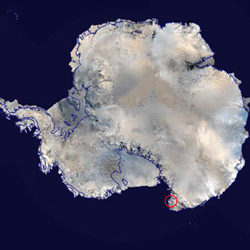The earliest multi-cellular organisms from the Antarctic The earliest multi-cellular organisms from the Antarctic
Professor David A. T. Harper, Ph.D., The Geological Museum, University of Copenhagen
Approximately 540 million years ago, life suddenly spread with great speed everywhere in the pre-biotic sea. The single-cell organisms’ niches were supplemented by, and to a high degree taken over by, multi-cellular animals with complex structures and organs. The event is called the Cambrian Explosion. This development is richly documented from the northern hemisphere, but only to a very limited extent from the southern hemisphere. This is especially a problem as the identification of fossils with a limited geographical extension have been a fundamental help in being able to construct the movements of the continents through geological time. However, detailed documentation is especially scant from one significant piece in the puzzle: the Antarctic. As this forbidding and frozen continent furthermore has had a key position relative to other continents through the past 500 million years, a team of scientists from the University of Copenhagen and the Geological Survey of Denmark and Greenland (GEUS) will seek to find new evidence of the life forms in the Antarctic, in order thus to be able with greater precision to place the pieces in this great global puzzle. From a helicopter, the research team will be airlifted from the expedition’s ship, “Vædderen” (“The Ram”) into the will mountain ranges of the northeastern Antarctic in order to study fossils and sediments. The project will produce greater knowledge of the earliest multi-cellular organisms of the Antarctic, the sediment environment of that time and the geological history of the continent.  |
|
|

|